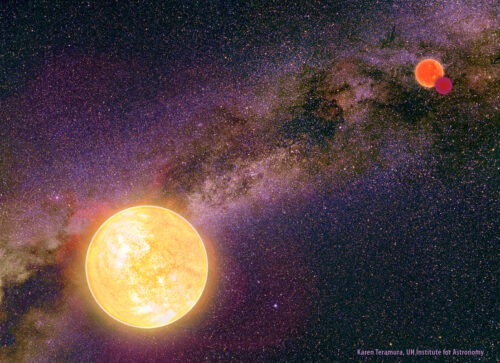Artwork by Karen Teramura for Bo Reipurt’s “Nature Paper” press release: “Our Sun is a single star. But in that respect it is somewhat unusual, because the majority of the stars in the sky are binary stars, two stars orbiting each other and bound together by their mutual gravity. Some of these binaries can be very close, in fact a few are so close that they actually touch each other. At the other end of the scale of separations, there are pairs that are extremely wide, with separations up to a light year or so. Their bonds are extremely tenuous and so as they slowly move through our Galaxy they are vulnerable to the gravitational tugs of passing stars. Eventually the effect of these disturbances build up and the wide binary breaks up, leading to two single stars that slowly drift apart. Astronomers have known about wide pairs of binary stars for a long time, but how they form has been a mystery. The typical cloud cores out of which stars are born are not large enough to form the widest binaries. Dr. Bo Reipurth of the Institute for Astronomy, University of Hawaii at Manoa, USA, and Dr. Seppo Mikkola of Tuorla Observatory, University of Turku, Finland, have used computer simulations to come up with a mechanism that accounts for the formation of wide binaries. Most stars are initially formed in small compact multiple systems with two, three or even more stars at the center of a cloud core. When more than two stars are together in a small space, they gravitationally pull on each other in a chaotic dance, where the lightest body is often kicked out to the outskirts of the core for long periods of time before falling back into the fray.”
Astronomisch nieuws, wetenswaardigheden én persoonlijke opinies
Recente berichten
- Uitbarsting van een mega-magnetische ster waargenomen in het nabij sterrenstelsel M82
- Video; Staart afgeblazen ‘duivelskomeet’ 12P/Pons-Brooks door zonnestorm daags voor zijn perihelium
- Nieuwe aanwijzingen gevonden voor het bestaan van Planeet 9
- Voor het eerst is een milliseconde pulsar ontdekt in het centrum van de Melkweg
- ‘Vervuiling’ als gevolg van een enorme explosie in NGC 4383 in beeld gebracht
Archief Astroblogs per maand
Meest gebruikte Astroblogs tags
67P
ALMA
astrofotografie
Cassini
Chandra
clusters
Curiosity
donkere materie
ESA
ESO
exoplaneten
Higgs bosonen
Hubble
infografieken
ISS
Jupiter
JWST
Kepler
kometen
LHC
maan
Mars
Melkweg
Mercurius
NASA
New Horizons
planetoïden
Pluto
pulsars
Rosetta
Saturnus
Sojoez
SpaceX
sterrenstelsels
stervorming
supernovae
superzware zwarte gaten
Venus
VLT
water
Webb
witte dwergen
zon
zwaartekrachtgolven
zwarte gaten
Copyright © 2024 · Genesis Framework · WordPress · Log in



Speak Your Mind